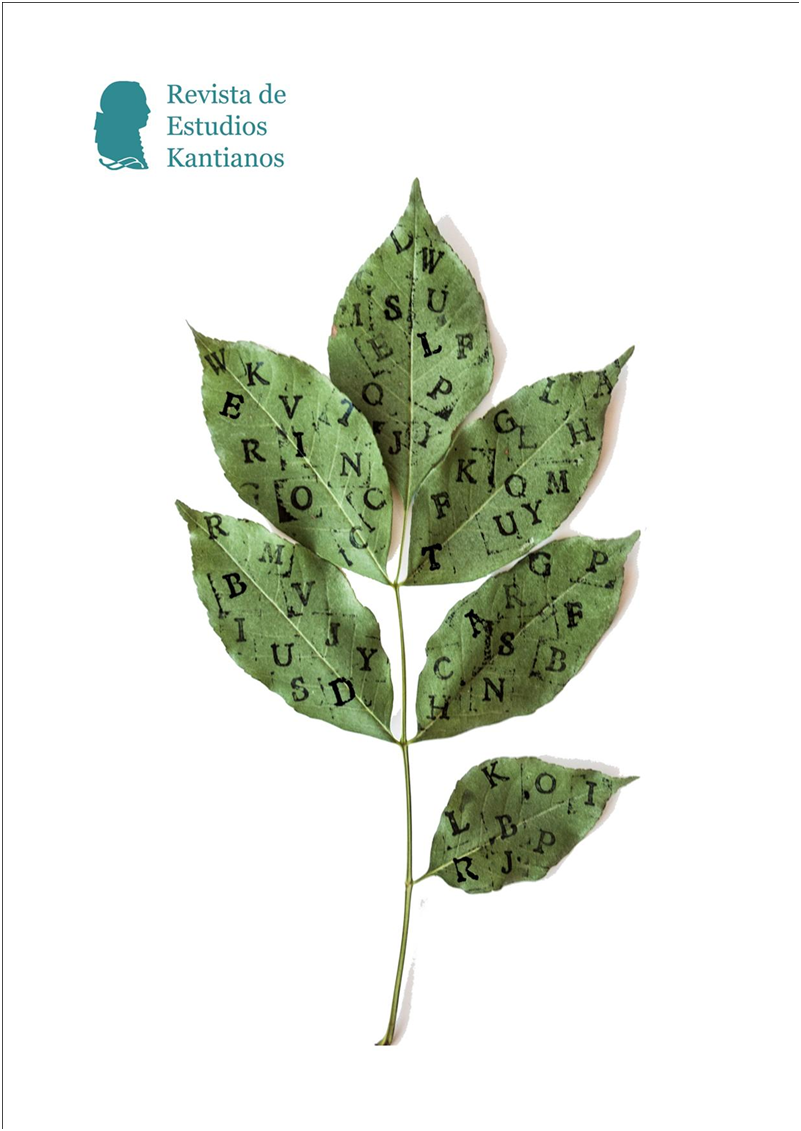Sobre las diferencias y afinidades estéticas de Kant y Solger
DOI:
https://doi.org/10.7203/REK.9.1.27210Keywords:
estética, particular, general, bello, sublime. Abstract
Abstract
Este artículo presenta las diferencias y afinidades entre las teorías estéticas de Kant y Solger. Para mostrar sus diferencias, la primera sección se centra en las objeciones de Solger a la estética kantiana, las cuales se dirigen al estatuto formal de lo bello y a su contenido moral. Tras ello, la segunda sección explica el significado dialéctico negativo de lo bello en la filosofía de Solger. Para mostrar sus afinidades, en la tercera sección se pone en relación lo sublime kantiano con el concepto solgeriano de lo bello. Ambas categorías estéticas se asemejan en que los dos expresan una relación negativa entre lo particular y lo general. En términos generales, este artículo sostiene la tesis de que en la estética poskantiana la categoría de lo sublime es integrada en la categoría de lo bello.
 Downloads
Downloads
 References
References
Allison, H. (2001). Kant’s Theory of Taste. Cambridge University Press. DOI.
Becker, O. (1929). “Von der Hinfälligkeit des Schönen und der Abenteuerlichkeit des Künstlers”. Festschrift für Husserl, Ergänzungsband zum Jahrbuch für philosophische und phänomenologische Forschung, 27-52.
Boucher, M. (1934). K.W.F. Solger. Esthétique et philosophie de la présence. Stock.
Bubbio, P. D. (2009a). Solger’s Notion of Sacrifice as Double Negation. Heythrop Journal, 50(2): 206-214. DOI.
Bubbio, P. D. (2009b). Solger and Hegel, Negation and Privation. International Journal of Philosophical Studies, 17(2): 173-187. DOI.
Colette, J. (1983). Art, Mystique et Négativité: K. W. F. Solger. Les Études Philosophiques, 1, 69-86. DOI.
Decher, F. (1994). Die Ästhetik K.W.F. Solgers. Winter.
Frank, M. (1989). Einführung in die frühromantische Ästhetik. Suhrkamp.
Galland-Szymkowiak, M. (2019). Between Romanticism and Idealism: Karl Wilhelm Ferdinand Solger, Philosophy as the Thought of Revelation. Symphilosophie International Journal of Philosophical Romanticism, 1, 39-59. DOI.
Galland-Szymkowiak, M. (2019). Between Romanticism and Idealism: Karl Wilhelm Ferdinand Solger, Philosophy as the Thought of Revelation. Symphilosophie International Journal of Philosophical Romanticism, 2, 313-346. DOI.
Heller, J. (1928), Solgers Philosophie der ironischen Dialektik. Von Reuther & Reichard.
Henckmann, W. (1971). Nachwort. En W. Henckmann, (Ed.), Karl W. F. Solger: Erwin. Vier Gespräche über das Schöne und die Kunst. Fink.
Henckmann, W. (1987). Der Begriff der Ironie bei K. W. F. Solger. Begegnung der Kulturen in Ost und West Festschrift für Hyogmyon Kwon zu s. 60. Geb., Soeul, pp. 155–170.
Homann, R. (1971-2007). Erhabene, das Erhabene. En Joachim Ritter, Karldfied Gründer et al (Eds.), Historisches Wörterbuch der Philosophie II (pp. 624–636). Schwabe.
Kant, I. (1900-). Gesammelte Schriften. De Gruyter.
Kaulbach F. (1984). Ästhetische Welterkenntnis bei Kant. Königshausen & Neumann.
Kierkegaard, S. (1961). Über den Begriff der Ironie. Mit ständiger Rücksicht auf Sokrates. Eugen Diederichs.
Mueller, G. E. (1941). Solger’s Aesthetics – A Key to Hegel (Irony and Dialectic). En A. Schirokauer y W. Paulsen(Eds.), Corona: Studies in Celebration of the Eightieth Birthday of Samuel Singer (pp. 212–27). Duke University Press.
Nishimura, K. (1980). Die Struktur des ästhetischen Bewußtseins bei K.W.F. Solger. Die Bedeutung der dialektischen Ironie, Perspektiven der Philosophie 6, 29-45. DOI.
Ophälders, M. (2016). Dialettica dell’ironia romantica. Mimesis. DOI.
Órdenes, P. (2023). Teleologische Erhabenheit der Vernunft bei Kant. Ein paradoxer Beweis der Einheit der Vernunft aus der Dualität des Erhabenen. De Gruyter, DOI.
Pinna, G. (1994). L’ironia Metafisica. Filosofia e teoria estetica in K.W.F. Solger. Pantograf. DOI.
Pinna G. (2005). Solgers Konzeption der Ironie. En Annemarie Gethmann-Siefert, Lu de Vos, Bernadette Collenberg-Plotnikov (Eds.), Die geschichtliche Bedeutung der Kunst und die Bestimmung der Künste (pp. 325-336). Fink.
Pinna, G. (2007). Il Sublime Romantico. Storia di un concetto sommerso. Centro Internazionale Studi di Estetica. DOI.
Pinna, G. (2014). Zum Verhältnis von Schönheit und Erhabenheit bei Solger. En Anne Baillot, Mildred Galland-Szymkowiak (Eds.), Grundzüge der Philosophie K.W.F. Solgers (pp. 39–50). LIT.
Pinna, G. (2017). Einleitung. Solger, K. W. F. Vorlesungen über Ästhetik. Felix Meiner.
Pinna, G. (2022). Un sentimento eccentrico. Friedrich Schlegel e il sublime romantico. Symphilosophie International Journal of Philosophical Romanticism 4, 189-412. DOI.
Rogozinski, J. (1998). A la limite de l’Ungeheuer sublime et ‘monstrueux’ dans la Troisième Critique. En Herman Parret(Ed.), Kants Ästhetik (pp. 642-59). De Gruyter. DOI.
Schelling, F. W. J. (2018). Historisch-Kritische Ausgabe. Bd. 6.1. pp. 190-199. Frommann-Holzboog.
Solger, K. W. F. (1907). Erwin. Vier Gespräche über das Schöne und die Kunst. Wiegandt & Grieben.
Solger, K. W. F. (2017). Vorlesungen über Ästhetik. Felix Meiner.
Solger, K. W. F. (1973). Nachgelassene Schriften. Lambert Scheider.
Tonelli, G. (1954). La formazione del testo della Kritik der Urteilskraft. Revue Internationale de Philosophie, 8, No. 30(4), 423-448. DOI.
Downloads
Additional Files
Published
How to Cite
-
Abstract212
-
PDF (Español)49
-
Sobre las diferencias y afinidades estéticas entre Kant y Solger (Español)9
Issue
Section
License
![]()
The authors who publish in this journal agree with the following terms:
- The authors retain their copyright and guarantee to the journal the right to be the first to publish the work and to license it under a Creative Commons Attribution License that allows others to share the work with an acknowledgement of its authorship and the initial publication in this journal.
- Authors may separately establish additional agreements for non-exclusive distribution of the version of the work published in the journal (for example, placing it in an institutional repository or publishing it in a book), with acknowledgement of its initial publication in this journal.
- Authors are allowed and encouraged to disseminate their work electronically (e.g., in institutional repositories or on their own website) before and during the submission process, as this can lead to productive exchanges as well as earlier and greater citation of published work (see The Effect of Open Access).








